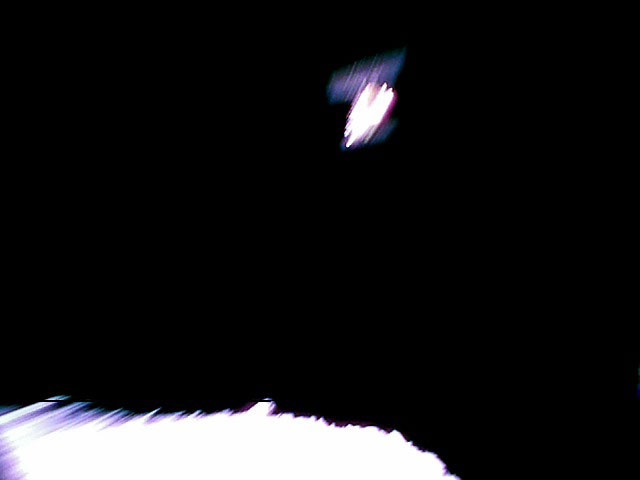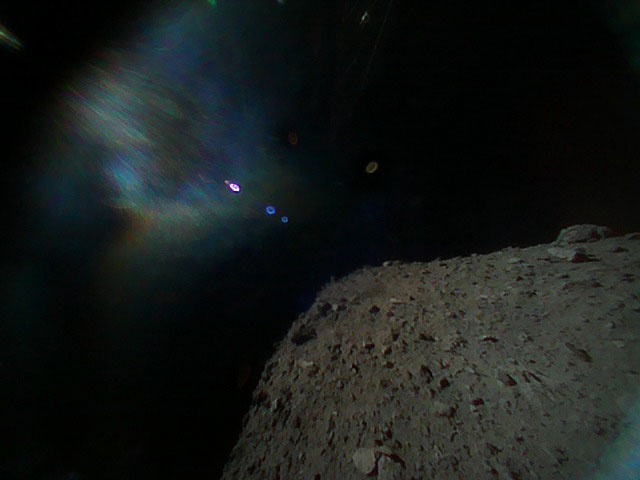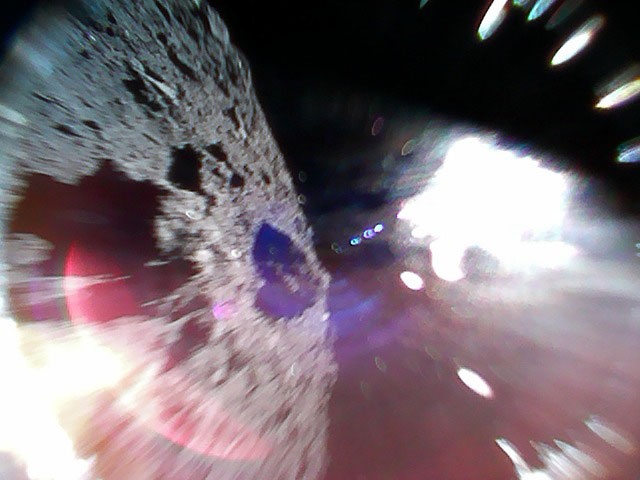MINERVA-II1: Successful image capture, landing on Ryugu, hop
MINERVA-II1: Successful image capture,
landing
on Ryugu and hop!
On September 21, the small compact MINERVA-II1 rovers separated from the Hayabusa2 spacecraft (time of separation was 13:06 JST). The MINERVA-II1 consists of two rovers, Rover-1A and Rover-1B. We have confirmed both rovers landed on the surface of asteroid Ryugu. The two rovers are in good condition and are transmitting images and data. Analysis of this information confirmed that at least one of the rovers is moving on the asteroid surface.
MINERVA-II1 is the world’s first rover (mobile exploration robot) to land on the surface of an asteroid. This is also the first time for autonomous movement and picture capture on an asteroid surface. MINERVA-II1 is therefore “the world’s first man-made object to explore movement on an asteroid surface”. We are also delighted that the two rovers both achieved this operation at the same time.
The following is a picture sent from MINERVA-II1.

Figure 1: Image captured by Rover-1A on
September 21 at around 13:08 JST. This is a color image
taken immediately after separation from the spacecraft.
Hayabusa2 is at the top and the surface of Ryugu is bottom.
The image is blurred because the shot was taken while the
rover was rotating.
(Image credit: JAXA)

Figure 2: Image captured by Rover-1B on
September 21 at around 13:07 JST. This color image was taken
immediately after separation from the spacecraft. The
surface of Ryugu is in the lower right. The coloured blur in
the top left is due to the reflection of sunlight when the
image was taken.
(Image credit: JAXA)

Figure 3: Image captured by Rover-1A on
September 22 at around 11:44 JST. Color image captured while
moving (during a hop) on the surface of Ryugu. The left-half
of the image is the asteroid surface. The bright white
region is due to sunlight.
(Image credit: JAXA).
The MINERVA-II1 cameras can shoot in color. In Figure 1, although the image is blurred due to the rover rotating, you can clearly see the body of Hayabusa2 and the paddle of the solar cells. The solar paddle appears blue. In Figure 3, the image was taken during a hop on the surface and you can feel this dynamic movement.
Operation of MINERVA-II1 will continue from now on. We are planning to acquire more data for analysis.
Comments from Project Members
Tetsuo Yoshimitsu, Responsible for the
Hayabusa2 Project MINERVA-II1.
Although I was
disappointed with the blurred image that first came from the
rover, it was good to be able to capture this shot as it was
recorded by the rover as the Hayabusa2 spacecraft is shown.
Moreover, with the image taken during the hop on the
asteroid surface, I was able to confirm the effectiveness of
this movement mechanism on the small celestial body and see
the result of many years of research.
Takashi
Kubota, Spokesperson for the Hayabusa2 Project (also
responsible for the MINERVA-II1)
The good news
made me so happy. From the surface of Ryugu, MINERVA-II1
sent a radio signal to the Earth via Hayabusa2 S/C. The
image taken by MINERVA-II1 during a hop allowed me to relax
as a dream of many years came true. I felt awed by what we
had achieved in Japan. This is just a real charm of deep
space exploration.
Yuichi Tsuda, Hayabusa2
Project Project Manager
I cannot find words to
express how happy I am that we were able to realize mobile
exploration on the surface of an asteroid. I am proud that
Hayabusa2 was able to contribute to the creation of this
technology for a new method of space exploration by surface
movement on small bodies.
Makoto Yoshikawa,
Hayabusa2 Project Mission Manager
I was so moved
to see these small rovers successfully explore an asteroid
surface because we could not achieve this at the time of
Hayabusa, 13 years ago. I was particularly impressed with
the images taken from close range on the asteroid surface.
Hayabusa2
project
2018.09.22


 Aotearoa Food Rescue Alliance: Grocery Market Reform Must Include Mandatory Food Rescue Partnerships
Aotearoa Food Rescue Alliance: Grocery Market Reform Must Include Mandatory Food Rescue Partnerships Hugh Grant: Zero Trust Security - A Buzzword Or The Ultimate Protection?
Hugh Grant: Zero Trust Security - A Buzzword Or The Ultimate Protection? Bill Bennett: Comcom revisits fibre rules as competition intensifies
Bill Bennett: Comcom revisits fibre rules as competition intensifies Bill Bennett: Download Weekly Extra - InternetNZ disrupted
Bill Bennett: Download Weekly Extra - InternetNZ disrupted Community Housing Aotearoa: Reducing Debt Financing Barriers For Community Housing Providers
Community Housing Aotearoa: Reducing Debt Financing Barriers For Community Housing Providers Bill Bennett: Apple iPad Air M3 - best tablet for creators in 2025
Bill Bennett: Apple iPad Air M3 - best tablet for creators in 2025



